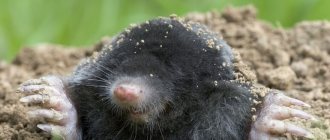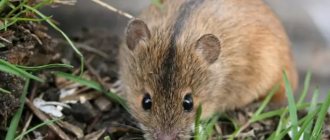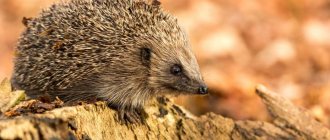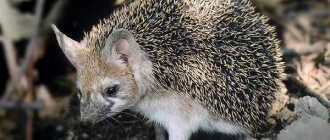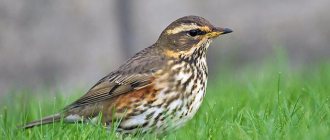- Wild animals
- >>
- Mammals
There are many amazing, even frightening creatures in the world. The latter can safely include the star-nosed mole, which, if not at the top, is certainly included in the list of the most “ugly” animals on our planet. The mole earned this title thanks to his unusual nose. However, the star-nosed fish is interesting not only for its extravagant appearance. You definitely need to learn more about this animal!
Origin of the species and description
Photo: Star-nosed
Star-nosed fish are also called star-nosed fish. In Latin their name is Condylura cristata. This is one of the most unique species of mammals. Starnoss is a bright representative of the mole family. In this family, it was allocated a separate subfamily, which is called the “Moles of the New World” subfamily. The decision to separate them into a separate subfamily was made due to the presence of special characteristics of starfish that distinguish them from other moles.
Video: Star-nosed
This type of mole loves water treatments, but the main difference from its closest relatives is their nose. It consists of twenty-two star-shaped skin growths. These growths are located directly on the animal’s face and do not look very attractive. In addition to the “ugly” nose, this mole is distinguished by hard brown fur and relatively small size - the length of the star-nosed mole usually does not exceed twenty centimeters.
Fun fact: Star-nosed is not your average mole. He not only loves to walk on the surface of the earth, but also loves to swim in the water. And the hard wool, which has a water-repellent effect, helps him in this.
The star-shaped growth on the face of this animal is unique. Scientists have found that it can be called the most sensitive tactile system in the world. This organ contains more than one hundred thousand nerve endings. This figure is five times greater than the sensitivity of the human hand! In addition, the star-shaped nose is able to perceive odors even under water. To do this, the animal releases bubbles into the water, then draws them back. According to scientists, it is these bubbles that allow the mole to smell prey in the water.
Benefit and harm to humans
Gardeners are afraid that moles are nibbling plants or gnawing roots. However, by destroying insects and their larvae, moles significantly help humans. They loosen the soil perfectly; the soil taken from mole hills is loose, it does not need to be sifted, it has a good structure. They also destroy wireworms and mole crickets - eternal enemies in the garden, caterpillars that eat plants. It has great benefits.
But if moles have multiplied on the site, this is no longer useful. This is a problem. They tear up flower beds, beds, paths. They dig everything up and undermine the plants. And they completely destroy earthworms, and they are also known to be very useful for soil formation.
There is no point in destroying their passages; they immediately build new ones. People have come up with effective means to combat large numbers of moles in areas. These are different traps, poisons, the method of pouring water into holes and repellers. A person also trains dogs or cats to hunt moles. Each of these methods has disadvantages.
To set a trap, you need to know which way the animal moves most often. It is inhumane to use poisons for extermination, and it is also unsafe for humans and other animals. You can fill the holes with water, but there is a chance that it will also fill the plants. And then the soil will dry out, and the animals will return.
Teaching a dog or cat to hunt moles is effective, but time consuming. Again, it depends on how many animals you have on your property. If there is a lot, your assistant will not be able to cope. Some people put nets in the ground or bury sharp objects, but such methods are not pleasant either.
A more humane and effective method is to install various repellers. Noise installations cause stress to the animal. He really doesn't like sharp sounds and leaves. True, loud noises can bother a person and his neighbors.
There are ultrasonic repellers and fragrances that repel animals. There are plants that, with their aroma, displace the mole from the site, for example, legumes, marigolds, lavender, calendula, garlic, and onions.
Appearance and features
Photo: What a starfish looks like
Star-nosed plants have a number of very characteristic external features:
- strong physique. The body of the star-nosed mole has a cylindrical shape, similar to the physique of an ordinary mole. It does not exceed twenty centimeters in length. The head is elongated, the neck is very short. Weight is approximately seventy grams;
- small eyes, lack of ears. Like all moles, the star-nosed mole has tiny eyes. Vision is very weak. The organs of vision are compensated by a well-developed sense of touch;
- developed front legs. The front pair of paws of the animal is intended for excavation work. The mole uses them to dig holes. The paws have long toes with large claws. The hind legs are similar in appearance to the front legs, but are not as developed;
- a long tail. This animal's tail can reach eight centimeters in length. It is completely covered with coarse hair. In winter, the tail stores fat, so its size increases slightly;
- dense, water-repellent, silky wool. Its color is dark - from brown to black;
- unusual nose. This is the most basic sign by which one can distinguish a star-nosed mole from an ordinary mole. The stigma consists of twenty-two skin growths. Such growths do not exceed four millimeters in length. They have many nerve endings that help the animal recognize prey.
Interesting fact: The predominantly underground lifestyle deprived moles of their vision. The eyes of such animals are underdeveloped. However, star-nosed animals were luckier than their closest relatives. They have a hypersensitive nose that allows them to receive necessary information from the outside.
Where does the starfish live?
Photo: Starnose in North America
Star-nosed birds have certain requirements for their habitat. Unlike other moles, these animals do not lead an exclusively underground lifestyle. They can often be seen on the surface of the earth and even in water. For this reason, animals prefer to live near a body of water. This is where they place their houses. The houses are a very complex system of passages with several chambers, entrances and exits. One of the exits usually leads directly into the water.
Climatic conditions are also extremely important for them. Starfish choose places with high humidity levels. In their natural habitat, they live in damp meadows, wetlands and coastlines. Such an animal cannot be found in the forest or dry steppe. Star-nosed birds avoid such areas.
Star-nosed mole is an American mole. It is widespread only in the New World. Its habitat includes the entire east coast of the United States and Canada. The habitat of the animal extends to the west – to the Great Lakes. The most interesting thing is the fact that star-noses in the south and north differ from each other. Southern animals are small, northern ones are larger. For this reason, scientists have identified two subspecies: northern, southern.
Now you know where the starfish is found. Let's see what this unusual animal eats.
Star-nosed - a special mole with a sensitive nose
Among the rare and unusual mammals on the planet, there is an animal about which its name star-nosed , or the middle name star-nosed, says a lot.
The nose in the shape of a multi-pointed star, adapted for digging underground passages and excellently functioning as an organ of touch, is the calling card of an inhabitant of the New World from the mole family.
What does the starfish eat?
Photo: Star-nosed Mole
Star-nosed moles are very active moles, which is also their distinguishing feature from other relatives. They spend almost the whole day searching for food, driven by their natural gluttony. Animals look for food everywhere: in water, on the surface of the earth and under it. They constantly dig tunnels in search of food. In one day, the starfish makes about six hunting trips. The rest of the time the animal is busy digesting food and resting.
The daily diet of starfish includes:
- small fish, crustaceans, mollusks;
- earthworms;
- some insects, their larvae;
- small mice, frogs.
The appetite and size of food eaten depends not only on the size of the animal, its habitat, but also on the time of year. Thus, gluttony is more pronounced in the summer. At this time, the mole can eat as much food per day as it weighs. At other times of the year, the feed size does not exceed thirty-five grams.
Most animals use their visual organs when hunting to find prey. Star-nosed moles hunt differently. Their sensitive star-shaped nose helps them get food. It uses its nose tentacles to find its prey, then holds it firmly with its front paws. The grip is very strong. Thanks to her, the star-nosed fish was recognized as one of the most skilled predators on the planet.
Nutrition
Surprisingly, the star-nosed mole is considered the mammal with the fastest feeding reflex. In just a quarter of a second, he can find, recognize and eat a small insect, larva or something similar.
Often this mole gets its food in bodies of water. He is not at all afraid of water and can spend quite a long time in it. In this environment, their diet consists of small crustaceans, fish and aquatic insects, such as the water strider bug or the swimming beetle.
In order to bite through the shell of an insect, which is quite hard for its size, the starfish needs powerful jaws. And indeed, examining this mole’s teeth under a microscope, scientists discovered that they were very sharp, especially the fangs. There are practically no flat teeth in the jaw, and its shape resembles that of a dog's jaw. Based on this feature, the starfish can be classified as a predator.
Features of character and lifestyle
Photo: Star-nosed mole
Star-nosed moles spend most of their time underground. They, like other relatives, are engaged in digging tunnels. These animals can create complex labyrinths with many chambers. Only small earthen mounds can give away their presence in a particular territory. In complex tunnels, animals make small chambers for themselves. In one of them they set up their burrow. There, star-nosed animals hide from enemies and raise their offspring.
The animals cover their burrows with twigs, grass, and dry plants. One of the burrow's exits always leads to a water source, where star-nosed birds love to spend their time. This type of mole visits the pond several times a day. They swim wonderfully and dive well. In winter, the starfish can be seen even under thick ice. These animals do not hibernate. In winter, they search for their food under the snow and actively hunt underwater inhabitants.
Interesting fact: Their anatomical features help star-nosed fish be agile underwater. They have strong, shovel-shaped feet and a long tail. They quickly move through the water with their paws, and use their tail as a rudder.
Starfishes are fairly balanced, social animals. They often create small colonies in which they exist peacefully and calmly. However, colonies often disintegrate. Outside the mating season, males and females do not stop their communication, which is also surprising. This is usually not typical for members of the mole family.
The nose of the starfish and its purpose
If it were not for the characteristic outgrowths, the nose of the star-nosed mole would be a completely normal and unremarkable nose. For example, the photograph below shows a common European mole:
And here is the star-nosed mole:
In general, the appearance of these animals is largely similar, and only the nose makes one of them an original that attracts everyone's attention.
The main feature of the nose of the star-nosed mole is special elongated skin growths located on the sides of the nostrils. There are 11 of them on each side, and what’s most interesting is that they are all mobile, moving with the help of muscles, controlled by the animal’s nervous system.
Each of the outgrowths is abundantly stuffed with nerve endings, making it a very effective organ of touch. By touching any object with such a “probe”, in a split second the mole manages to assess its temperature, mobility, hardness and, most importantly, the edibility of the object.
This is interesting
Research shows that the star-nosed mole only needs 8 milliseconds to use its nose to assess the edibility of an object. Today it is one of the fastest analyzers in the animal world, and the Guinness Book of Records calls the star-nosed mole the fastest mammal hunter (not in terms of movement speed, but in terms of hunting speed). In a second, the animal is able to check up to 13 different objects.
The human eye is not able to follow the movements of moving outgrowths, and to study their work it is necessary to use high-speed video cameras.
The growths on the nose of the starfish (scientists call them tendrills) are constantly in motion, feeling the surfaces located close to them. Since all such “tentacles” are directed centrifugally in different directions from the nostril, they create a star-shaped nose, and this “star” has a diameter of only about a centimeter and, for example, is smaller in size than the fingernail of an adult man.
However, the total surface area of skin on tendrills is approximately 8 times greater than the skin surface area on the nose of any other mole, giving the starbill an advantage in speed and thoroughness of territory survey compared to its other relatives.
On a note
The area of the sensitive part of the nose of the European mole is approximately 0.11 square meters. centimeter, while in the starfish it reaches 0.92 square meters. cm.
At the same time, the sensitivity of different parts of the animal’s nose varies. The eleventh, the smallest internal pair of outgrowths is the most sensitive, and the remaining 10 pairs work in the “touching eyes” mode, studying the situation and directing the 11th highly sensitive pair for a more thorough study of the object.
In the photo you can count the pairs of outgrowths on the nose of the star-nosed mole:
The most sensitive of them is the one whose outgrowths are the shortest, located in the lower center.
Interestingly, the sensitive processes in the star-nosed fish work in the same mode in which the eyes of various mammals work when they perform saccades (saccades are coordinated eye movements that occur in one direction at the same time). Thanks to the constant movement of the outgrowths, the mole can evaluate the surface structure of any object in much the same way as a person would examine it with his eyes. So, the animal can figure out with lightning speed whether there is an insect in front of it, or just a lump of earth.
At the same time, tendrills do not smell and are not able to catch prey. All they do is simply touch, and their mechanical sensitivity is so great that by touching the surface, the star-nosed mole can feel vibrations in the soil caused, for example, by an insect that is still far from it.
This is interesting
Each mobile projection on the nose of the star-nosed mole is covered with a unique epidermis not found in any other mammal. The entire “star” on the nose of the starfish bears more than 25 thousand tiny papillae with a diameter of approximately 50 micrometers, and each such papilla is riddled with nerve endings. As a result, the entire organ turns out to be approximately 6 times more sensitive, compared to the potential sensitivity of the fingertips on a person’s hands.
It is also interesting that individual receptors on the mobile projections of the star-nosed mole are sensitive to rubbing, but do not respond to pressure. Others, on the contrary, are sensitive to pressure. All of them are located mixed up on the surface, and therefore the animal feels equally well any kind of touch on its “star”.
It is also useful to read: How does a mole winter and does it hibernate in the cold season?
In actual work, the nose is a constantly moving organ. The star-nosed mole itself moves very quickly, but as it moves, it manages to probe almost every square millimeter of the surface of its course underground. Considering that there is no light here, the animal can only rely on the sense of smell and sensitivity of the outgrowths themselves.
As soon as with its “tentacles” the mole stumbles upon something similar to prey, it immediately carefully and very quickly feels it, and if it really turns out to be a living creature, it bites and tries to eat it. As a rule, he succeeds.
This is interesting
It is also assumed that the starfish's nose can pick up electrical impulses created by the contraction of the muscles of a potential victim, which makes it easier for the mole to detect food.
Social structure and reproduction
Photo: Baby starnose
The starfish can be safely called a monogamous creature. These animals find a mate in the colony, mate, raise offspring and continue their communication with each other. Even outside the mating season, females and males do not stop their family “relationships”. However, each adult also has its own personal “freedom”. Each starfish has separate burrows, chambers for resting and living.
The mating season for these moles occurs once a year. It occurs in the spring, but the exact timing differs in different regions of the natural habitat. So, in the north, the mating season begins in May, and in the south - in March. The mating season lasts only a few months. The female's pregnancy lasts up to forty-five days. At one time, the female bears four cubs. However, sometimes the litter can reach seven babies in one pregnancy.
The offspring of starfish are born completely defenseless, completely naked. At first, the unusual star-shaped nose on the muzzle of moles is almost not noticeable. A distinctive feature of star-nosed babies is their rapid development. Babies can already lead an independent life thirty days after birth. After thirty days, the animals fully adapt to the environment, switch to an adult diet, and actively explore nearby areas.
Interesting Facts
- Its body hair can bend in any direction, this allows the mole to run forward along its underground passages not only with its head, but also with its tail. He easily navigates in space and moves at the same speed in both cases.
- Moles shed not twice a year, but much more often. Constant movement through narrow passages wears out their fur, forcing them to get rid of frayed fur several times a year.
- In terms of the volume of food he eats, he is almost a record holder. Weighing from 45 to 85 grams, he eats up to 22 grams of earthworms at one time, and 50-60 grams per day. This is almost his body weight.
- It is not recommended to keep moles in captivity. He must constantly dig the ground, otherwise he will become obese. No fillers can replace the composition of soil. Without performing the usual excavation work, the animal will die.
- Archaeological scientists from Denmark decide to find a use for moles. They use them as search engines, since when they dig the ground, they push out everything that is in it. Artifacts also fall into this process.
- Moles have a highly developed seismic sense; they “predict” earthquakes.
Natural enemies of starfish
Photo: What a starfish looks like
Star-nosed fish are defenseless against most predators. This is mainly due to their active lifestyle. This species, unlike other representatives of moles, spends its time not only underground. Starfish travel a lot on the surface of the earth, diving and swimming in bodies of water. On land and in water, these small animals face many dangers. In addition, their weak eyesight “plays” against moles. Animals simply do not see predators approaching.
The most dangerous natural enemies of star-nosed insects include:
- birds of prey. Starfish are a favorite delicacy of large owls, eagles, hawks, eagle owls, and falcons;
- martens, skunks;
- largemouth bass, large frogs.
Predators catch and eat small moles as they crawl through vegetation, walk toward a body of water, or swim in the water. During the winter period, predators got used to getting starfish from underground chambers. Humans can also be called the natural enemy of the starfish. People rarely kill this animal, but they cause harm in other ways. Human settlements have significantly dismembered the natural habitat of these animals. But, fortunately, this did not have such a strong impact on the total number of starfish.
Notes
- ↑ 1 2 Sokolov V. E.
Five-language dictionary of animal names. Mammals. Latin, Russian, English, German, French. / under the general editorship of academician. V. E. Sokolova. - M.: Rus. lang., 1984. - P. 42. - 10,000 copies. - Complete illustrated encyclopedia. "Mammals" Book. 2 = The New Encyclopedia of Mammals / ed. D. MacDonald. - M.: "Omega", 2007. - P. 440. - 3000 copies. — ISBN 978-5-465-01346-8.

